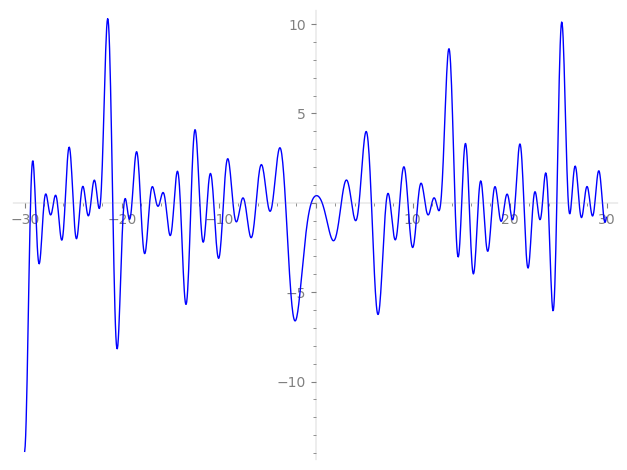| L(s) = 1 | + (−0.529 + 1.31i)2-s + (−0.836 + 0.482i)3-s + (−1.43 − 1.38i)4-s − 3.93·5-s + (−0.189 − 1.35i)6-s + (−0.866 − 0.5i)7-s + (2.58 − 1.14i)8-s + (−1.03 + 1.79i)9-s + (2.08 − 5.15i)10-s + (−0.864 − 1.49i)11-s + (1.87 + 0.467i)12-s + (−3.49 + 0.882i)13-s + (1.11 − 0.870i)14-s + (3.29 − 1.89i)15-s + (0.136 + 3.99i)16-s + (1.48 − 2.56i)17-s + ⋯ |
| L(s) = 1 | + (−0.374 + 0.927i)2-s + (−0.482 + 0.278i)3-s + (−0.719 − 0.694i)4-s − 1.75·5-s + (−0.0774 − 0.552i)6-s + (−0.327 − 0.188i)7-s + (0.913 − 0.406i)8-s + (−0.344 + 0.596i)9-s + (0.659 − 1.63i)10-s + (−0.260 − 0.451i)11-s + (0.540 + 0.135i)12-s + (−0.969 + 0.244i)13-s + (0.297 − 0.232i)14-s + (0.849 − 0.490i)15-s + (0.0342 + 0.999i)16-s + (0.359 − 0.622i)17-s + ⋯ |
\[\begin{aligned}\Lambda(s)=\mathstrut & 728 ^{s/2} \, \Gamma_{\C}(s) \, L(s)\cr =\mathstrut & (0.794 - 0.607i)\, \overline{\Lambda}(2-s) \end{aligned}\]
\[\begin{aligned}\Lambda(s)=\mathstrut & 728 ^{s/2} \, \Gamma_{\C}(s+1/2) \, L(s)\cr =\mathstrut & (0.794 - 0.607i)\, \overline{\Lambda}(1-s) \end{aligned}\]
Particular Values
| \(L(1)\) |
\(\approx\) |
\(0.372401 + 0.126057i\) |
| \(L(\frac12)\) |
\(\approx\) |
\(0.372401 + 0.126057i\) |
| \(L(\frac{3}{2})\) |
|
not available |
| \(L(1)\) |
|
not available |
\(L(s) = \displaystyle \prod_{p} F_p(p^{-s})^{-1} \)
| $p$ | $F_p(T)$ |
|---|
| bad | 2 | \( 1 + (0.529 - 1.31i)T \) |
| 7 | \( 1 + (0.866 + 0.5i)T \) |
| 13 | \( 1 + (3.49 - 0.882i)T \) |
| good | 3 | \( 1 + (0.836 - 0.482i)T + (1.5 - 2.59i)T^{2} \) |
| 5 | \( 1 + 3.93T + 5T^{2} \) |
| 11 | \( 1 + (0.864 + 1.49i)T + (-5.5 + 9.52i)T^{2} \) |
| 17 | \( 1 + (-1.48 + 2.56i)T + (-8.5 - 14.7i)T^{2} \) |
| 19 | \( 1 + (-0.479 + 0.831i)T + (-9.5 - 16.4i)T^{2} \) |
| 23 | \( 1 + (-0.176 - 0.305i)T + (-11.5 + 19.9i)T^{2} \) |
| 29 | \( 1 + (-0.0559 + 0.0322i)T + (14.5 - 25.1i)T^{2} \) |
| 31 | \( 1 - 4.86iT - 31T^{2} \) |
| 37 | \( 1 + (-3.57 - 6.19i)T + (-18.5 + 32.0i)T^{2} \) |
| 41 | \( 1 + (-3.88 + 2.24i)T + (20.5 - 35.5i)T^{2} \) |
| 43 | \( 1 + (-9.27 - 5.35i)T + (21.5 + 37.2i)T^{2} \) |
| 47 | \( 1 - 4.29iT - 47T^{2} \) |
| 53 | \( 1 + 8.51iT - 53T^{2} \) |
| 59 | \( 1 + (0.0552 - 0.0957i)T + (-29.5 - 51.0i)T^{2} \) |
| 61 | \( 1 + (8.85 + 5.11i)T + (30.5 + 52.8i)T^{2} \) |
| 67 | \( 1 + (-3.49 - 6.05i)T + (-33.5 + 58.0i)T^{2} \) |
| 71 | \( 1 + (10.5 + 6.09i)T + (35.5 + 61.4i)T^{2} \) |
| 73 | \( 1 + 15.5iT - 73T^{2} \) |
| 79 | \( 1 - 10.0T + 79T^{2} \) |
| 83 | \( 1 + 12.7T + 83T^{2} \) |
| 89 | \( 1 + (-2.95 + 1.70i)T + (44.5 - 77.0i)T^{2} \) |
| 97 | \( 1 + (3.13 + 1.80i)T + (48.5 + 84.0i)T^{2} \) |
| show more | |
| show less | |
\(L(s) = \displaystyle\prod_p \ \prod_{j=1}^{2} (1 - \alpha_{j,p}\, p^{-s})^{-1}\)
Imaginary part of the first few zeros on the critical line
−10.51537598790076683514027815280, −9.516565590382181994336233690434, −8.530463507894280665601118802523, −7.70443942238173226713645803891, −7.29798712418913494370027214234, −6.14386133318694160943712425395, −4.95784210598627030476699783375, −4.45598545463902458988187783656, −3.11130500424576463461339405523, −0.45513703818568126683493543226,
0.66046302928153947233567083344, 2.63877378767878765330840361503, 3.69760799561200980345573909502, 4.46906954568067972285046655399, 5.74270559535789787636447645744, 7.25708877943843916983275711799, 7.67164421450413369533407562721, 8.653700791787710674949947103272, 9.506622839875506561426866325436, 10.52402479668032932870625442821

